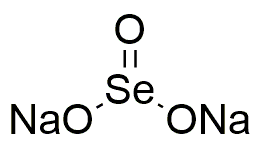Sodium selenite is widely utilized in research focused on:
- Nutritional Supplements: It serves as a source of selenium, an essential trace element for human health, often found in dietary supplements aimed at boosting immune function and antioxidant activity.
- Agriculture: Used as a micronutrient fertilizer, it helps improve soil quality and plant growth, particularly in selenium-deficient areas, enhancing crop yield and nutritional value.
- Pharmaceuticals: In the medical field, sodium selenite is explored for its potential therapeutic effects in cancer treatment and as an adjunct therapy for certain diseases due to its antioxidant properties.
- Analytical Chemistry: It is employed in various analytical methods, including spectrophotometry, for the detection and quantification of selenium in environmental samples, ensuring compliance with safety standards.
- Industrial Applications: Sodium selenite is used in the production of glass and ceramics, where it acts as a colorant and improves the durability of the final product.
General Information
Properties
Safety and Regulations
Applications
Sodium selenite is widely utilized in research focused on:
- Nutritional Supplements: It serves as a source of selenium, an essential trace element for human health, often found in dietary supplements aimed at boosting immune function and antioxidant activity.
- Agriculture: Used as a micronutrient fertilizer, it helps improve soil quality and plant growth, particularly in selenium-deficient areas, enhancing crop yield and nutritional value.
- Pharmaceuticals: In the medical field, sodium selenite is explored for its potential therapeutic effects in cancer treatment and as an adjunct therapy for certain diseases due to its antioxidant properties.
- Analytical Chemistry: It is employed in various analytical methods, including spectrophotometry, for the detection and quantification of selenium in environmental samples, ensuring compliance with safety standards.
- Industrial Applications: Sodium selenite is used in the production of glass and ceramics, where it acts as a colorant and improves the durability of the final product.
Documents
Safety Data Sheets (SDS)
The SDS provides comprehensive safety information on handling, storage, and disposal of the product.
Product Specification (PS)
The PS provides a comprehensive breakdown of the product’s properties, including chemical composition, physical state, purity, and storage requirements. It also details acceptable quality ranges and the product's intended applications.
Certificates of Analysis (COA)
Search for Certificates of Analysis (COA) by entering the products Lot Number. Lot and Batch Numbers can be found on a product’s label following the words ‘Lot’ or ‘Batch’.
*Catalog Number
*Lot Number
Certificates Of Origin (COO)
This COO confirms the country where the product was manufactured, and also details the materials and components used in it and whether it is derived from natural, synthetic, or other specific sources. This certificate may be required for customs, trade, and regulatory compliance.
*Catalog Number
*Lot Number
Safety Data Sheets (SDS)
The SDS provides comprehensive safety information on handling, storage, and disposal of the product.
DownloadProduct Specification (PS)
The PS provides a comprehensive breakdown of the product’s properties, including chemical composition, physical state, purity, and storage requirements. It also details acceptable quality ranges and the product's intended applications.
DownloadCertificates of Analysis (COA)
Search for Certificates of Analysis (COA) by entering the products Lot Number. Lot and Batch Numbers can be found on a product’s label following the words ‘Lot’ or ‘Batch’.
*Catalog Number
*Lot Number
Certificates Of Origin (COO)
This COO confirms the country where the product was manufactured, and also details the materials and components used in it and whether it is derived from natural, synthetic, or other specific sources. This certificate may be required for customs, trade, and regulatory compliance.


